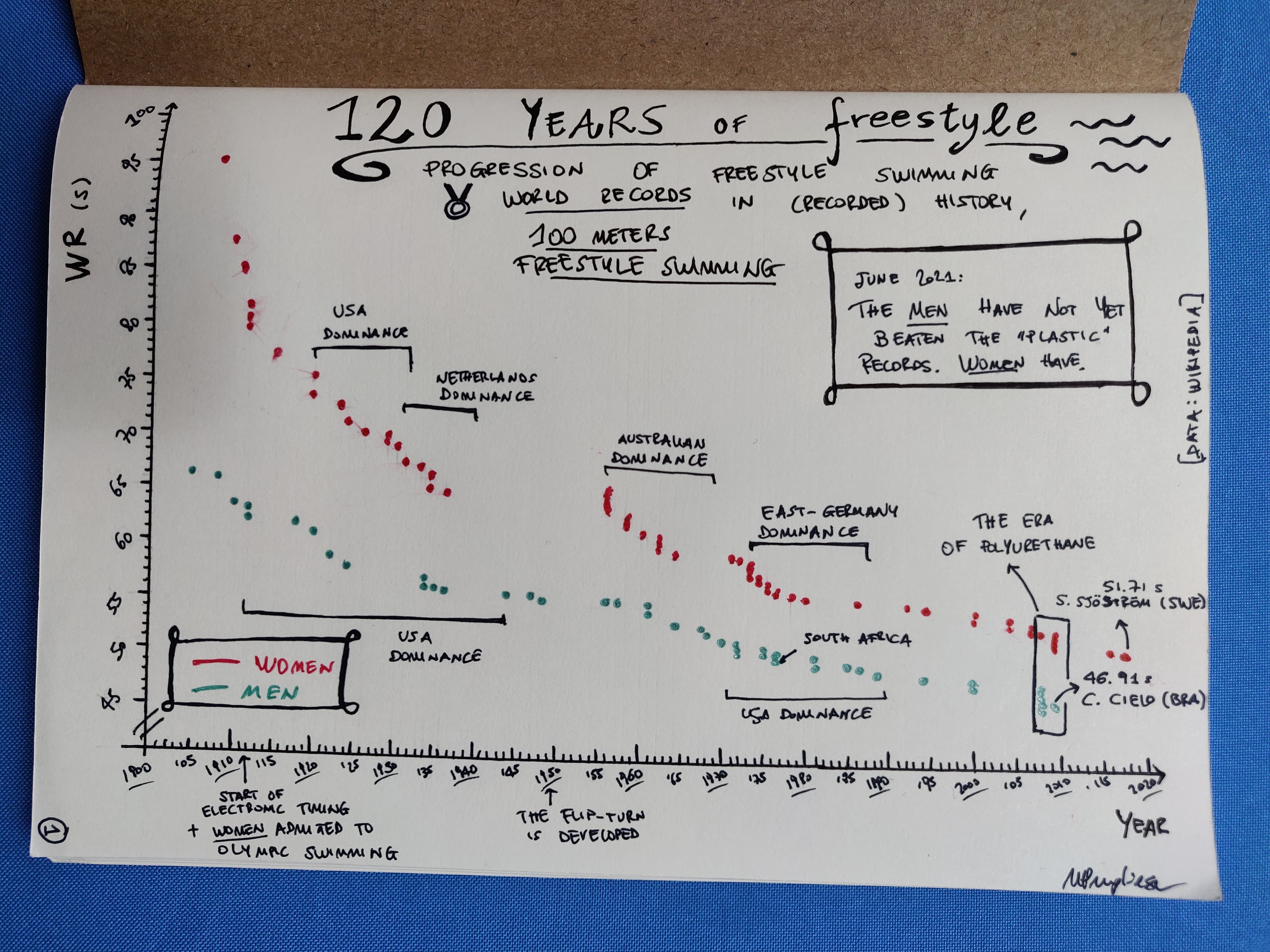The world records in freestyle swimming, in data
Lately, I’ve had this idea of starting to viz data about sport; after all, sport is one of those areas where there’s a wonderfully interesting crossing of science, politics, social and cultural elements, and so on. Plus, I love sports - both practicing them and watching them. And oh, I’m really excited about the coming Olympics (as I always am!). This isn’t the first time I’ve been vizzing some data about sports, generally speaking, but I will try to do this more systematically.
Anyway, here I’ve been looking at the world records set in freestyle (pool) swimming: swimming is a favourite sport of mine and freestyle its most regal representation. Note that freestyle and breaststroke are the two styles which have been part of the Olympics since the very start of the modern era (1896).
In the card below, I’m plotting the timeline of world records set in freestyle swimming for both men and women in the 100 meters race, I’ve gathered the data from Wikipedia. I’m not sure what the first point in each timeline represents, meaning what determined the recording of the first record (pun not intended), which sits at 1905 for men and 1908 for women. In the following, when talking about the Olympics we will refer to those of the modern era; the timeline covers all world records independently of the event in which they’ve been set (Olympics or anything else).
Note a few things, to contextualise some of this data (information taken again from Wikipedia):
- Swimming in the first four Olympics has been held in open waters, not a pool;
- Women’s participation in Olympics swimming started in 1912, which was also the first year of electronic timing;
- The 1924 Olympics were the first to use the standard 50 meters pool;
- Diving blocks were added starting from the 1936 Olympics (presumably before then swimmers used to dive from the pool border itself, and this would make a difference in the initial length spanned when entering water);
- The flip-turn was only developed in the ’50s;
- The years 2008-2009 were the era of polyurethane and full-body suits: Speedo developed a new kind of swimsuit - I’m not sure exactly when - that was full-body length and polyurethane-based, that majorly aided performance, other manufacturers followed so those two years saw very many records destroyed. In early 2010, the polyurethane swimsuits have been banned from use in competitions, alongside anything at full-body length. Note that these years encompassed two major events: the 2008 Beijing Olympics and the 2009 World Championships (nicknamed “the plastic games” due to the extensive use of those particular suits).

Both men’s and women’s times have been dropping quite significantly in the last 120 years or so: men have gained about 25 seconds, women exhibit an even sharper decline (especially looking at the early days) which makes the gain sit at around 45 seconds. Incredible. It would be due to a combination of better technique, more training, better equipment and the fact that we all care more about setting records than we used to, I guess?
Let’s look at some little stats from these series.
| Men | Women | |
|---|---|---|
| Number of records set since the first one | 50 | 66 |
| Percentage of records set at the Olympics | 26 | 15 |
| Average difference (days) between consecutive records | 772 | 611 |
So, women have more records set and a much shorter time difference between them, on average. I wonder if there is a cultural effect related to the historical inequity between genders: less women participating to the sport in the first place, less women arriving at elite category, which implies that has been more to gain for women in terms of beating the clock. But I’m just speculating.
Another interesting thing to notice is the fact that the country with the highest number of records is the USA for men and Australia for women. The second ranking country for women is East Germany (which doesn’t have any records for men), and because it’s now well known that many of those athletes were unknowingly doped, whether they would have earned those records without drugs is a good question. Of course, the presence of many records by East Germany in the women’s timeline (14) may affect what we were saying earlier about the slight disparity with men’s.
The current records are 46.91s for men (C. Cielo, set in the 2009 World Championships in Rome) and 51.71s for women (S. Sjöström, set in the 2017 World Championships in Budapest). Women have set two more records since the polyurethane era (so, after 2009), men still have to beat those times; I have not gone checking what specific swimsuit each record holder wore at the time of the record, but given the ban these last women’s ones should be with regular suits.
Now the big question is whether there is still some leeway to gain for the human species in regards to getting faster at swimming. The literature is full of works that try to estimate the maximum swimming speed for humans from the data, but I was wondering if there were biological considerations that can hint at a maximum achievable performance after which our biology can’t go. I didn’t find much, though I’m sure there are works.
Read more
- L Foster, D James, S Haake, Influence of full body swimsuits on competitive performance, Procedia Engineering, 34, 2012
- A Marck et al., Are We Reaching the Limits of Homo sapiens?, Front. Physiol, 2017